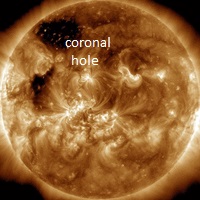ROCKET LAUNCH FOILED BY SOLAR ACTIVITY: Orbital Sciences Corp. scrubbed today's launch of their Antares supply rocket to the International Space Station in response to an ongoing solar radiation storm, described below. A launch at 1:10 p.m. EST Thursday is possible if the storm subsides. [more]
STORMY SPACE WEATHER: Giant sunspot AR1944 is directly facing Earth and crackling with solar flares. Yesterday, Jan. 7th, an X1-class explosion in the sunspot's magnetic canopy hurled a CME in our direction. Sky watchers shoud be alert for auroras on Jan. 9th when the cloud arrives. NOAA forecasters estimate a 60% chance of strong geomagnetic storms. Aurora alerts: text, voice.
The X1-flare that hurled the CME toward Earth also accelerated a swarm of high-energy protons in our direction. Effects of the proton fusillade are visible in this Jan. 7th coronagraph movie from the Solar and Heliospheric Observatory (SOHO):
The "snow" in this movie is caused by solar protons striking the spacecraft's CCD camera. A veritable blizzard of speckles develops as the CME emerges into full view. Indeed, many of the protons are accelerated by shock waves at the forefront of the expanding cloud.
This ongoing radiation storm ranks S2 on NOAA storm scales. It is rich in "hard" protons with more than 100 MeV of energy, which accounts for the snowiness of the SOHO coronagraph images. According to NOAA, "passengers and crew in high-flying aircraft at high latitudes may be exposed to elevated radiation risk" during such a storm.
The source of all this activity is AR1944, one of the biggest sunspots of the past decade. The sprawling active region is more than 200,000 km wide and contains dozens of dark cores. Its primary core, all by itself, is large enough to swallow Earth three times over. To set the scale of the behemoth, Karzaman Ahmad inserted a picture of Earth in the corner of this picture he took on Jan. 7th from the Langkawi National Observatory in Malaysia:
More flares are in the offing. The sunspot has an unstable 'beta-gamma-delta' magnetic field that is likely to erupt again today. NOAA forecasters estimate an 80% chance of M-class flares and a 50% chance of X-flares on Jan. 8th. Solar flare alerts: text, voice.

Solar wind
speed: 317.7 km/sec
density: 6.5 protons/cm3
explanation | more data
Updated: Today at 1727 UT
X-ray Solar Flares
6-hr max: C6 1204 UT Jan08
24-hr: M3 0347 UT Jan08
explanation | more data
Updated: Today at: 1700 UT
![]()
Daily Sun: 08 Jan 14
Giant sunspot AR1944 has a 'beta-gamma-delta' magnetic field that harbors energy for X-class solar flares. Credit: SDO/HMI
![]()
Sunspot number: 196
What is the sunspot number?
Updated 08 Jan 2014
Spotless Days
Current Stretch: 0 days
2013 total: 0 days (0%)
2012 total: 0 days (0%)
2011 total: 2 days (<1%)
2010 total: 51 days (14%)
2009 total: 260 days (71%)
Since 2004: 821 days
Typical Solar Min: 486 days
Update 08 Jan 2014
The Radio Sun
10.7 cm flux: 237 sfu
explanation | more data
Updated 08 Jan 2014
![]()
Current Auroral Oval:
Switch to: Europe, USA, New Zealand, Antarctica
Credit: NOAA/POES
![]()
Planetary K-index
Now: Kp= 1 quiet
24-hr max: Kp= 3 quiet
explanation | more data
Interplanetary Mag. Field
Btotal: 4.5 nT
Bz: 1.4 nT north
explanation | more data
Updated: Today at 1726 UT
![]()
Coronal Holes: 08 Jan 14
Solar wind flowing from this emerging coronal hole should reach Earth on Jan. 12-13. Credit: SDO/AIA.






